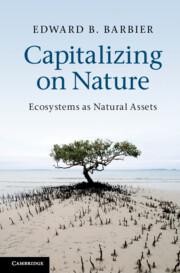Book contents
- Frontmatter
- Contents
- Figures
- Tables
- Boxes
- Acknowledgments
- Introduction
- 1 Ecological scarcity as an economic problem
- 2 Ecosystem services and ecological landscapes
- 3 The basic natural asset model
- 4 Spatial variation in ecosystems
- 5 The open economy
- 6 Ecological collapse
- 7 The way ahead
- 8 Policies in the Age of Ecological Scarcity
- Index
- References
7 - The way ahead
Published online by Cambridge University Press: 05 June 2012
- Frontmatter
- Contents
- Figures
- Tables
- Boxes
- Acknowledgments
- Introduction
- 1 Ecological scarcity as an economic problem
- 2 Ecosystem services and ecological landscapes
- 3 The basic natural asset model
- 4 Spatial variation in ecosystems
- 5 The open economy
- 6 Ecological collapse
- 7 The way ahead
- 8 Policies in the Age of Ecological Scarcity
- Index
- References
Summary
Ecosystems are capital assets. Like reproducible capital assets (roads, buildings, and machinery), ecosystems depreciate if they are misused or are overused. But they differ from reproducible capital assets in three ways: (1) depreciation of natural capital is frequently irreversible (or at best the systems take a long time to recover), (2) except in a very limited sense, it isn’t possible to replace a depleted or degraded ecosystem by a new one, and (3) ecosystems can collapse abruptly, without much prior warning.
(Dasgupta 2008, p. 3)Introduction
The above quote by Partha Dasgupta summarizes succinctly the main theme of this book. Ecosystems are a special and unique form of capital asset and, as a result, the various goods and services that they provide us are not routinely reflected in markets and policy decisions. Most importantly, however, the quote reminds us of how much we still do not know about these unique capital assets. Overcoming this gap in knowledge is clearly a major research challenge. Natural science and economics are important to enhancing our understanding of ecosystems as natural assets, but only if these disciplines are applied jointly to the problem. That is, significant progress in the major research questions concerning ecosystems as natural assets can only be achieved through interdisciplinary collaboration between economists, ecologists, and environmental scientists.
The purpose of the following chapter is to point “the way ahead” for such interdisciplinary research. The preceding chapters have pointed to several key research issues that are necessary to make further progress in assessing the contributing of ecosystems to human well-being. These issues are:
the key advances that will be required to improve economic valuation of ecosystem goods and services;
the research needed to determine how spatially heterogeneous landscapes influence the provision of ecosystem benefits, thus helping to identify the important biophysical and economic attributes of each landscape parcel in each location to optimize conservation decisions across ecological landscapes;
the research required to analyze phases of ecological transition and assist restoration of degraded ecosystems;
the need for more economic empirical and analytical studies to verify the conditions under which an open economy is likely to conserve rather than convert ecological landscapes, thus generating a greater flow of ecosystem services; and
the research collaboration required to determine how the threat of collapse and the presence of thresholds affects the management of ecosystems as natural assets.
- Type
- Chapter
- Information
- Capitalizing on NatureEcosystems as Natural Assets, pp. 232 - 268Publisher: Cambridge University PressPrint publication year: 2011



